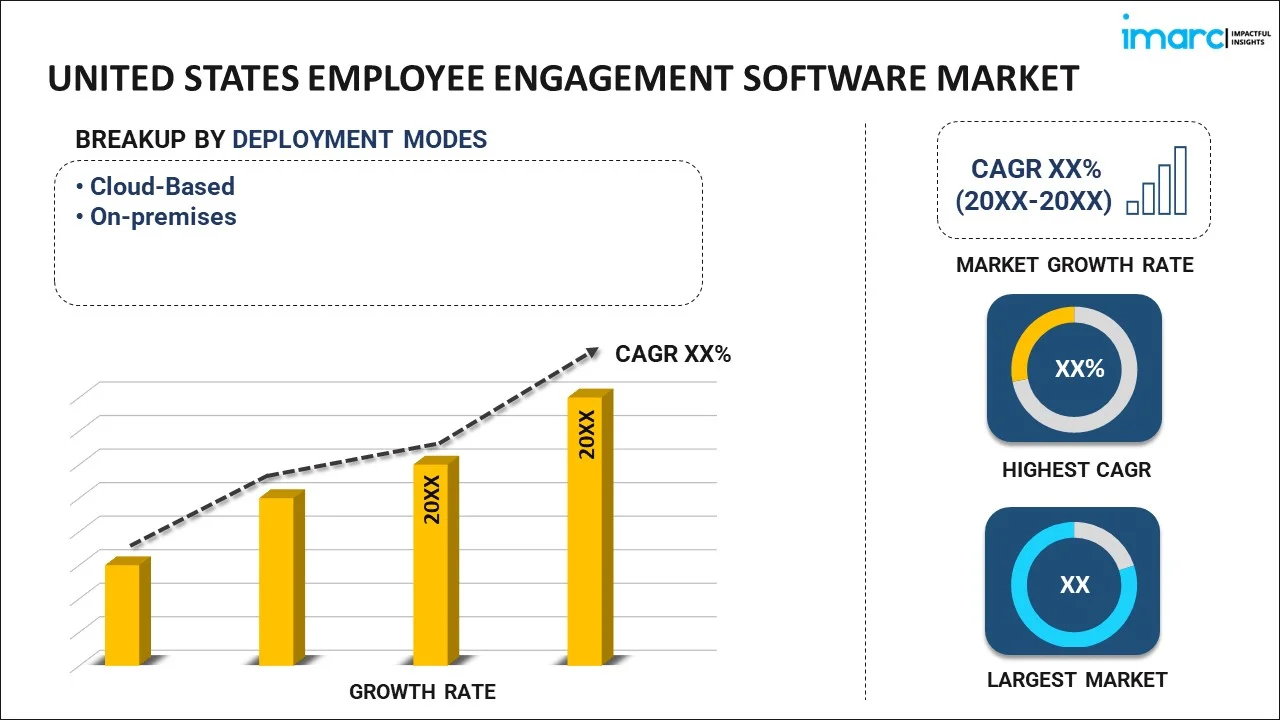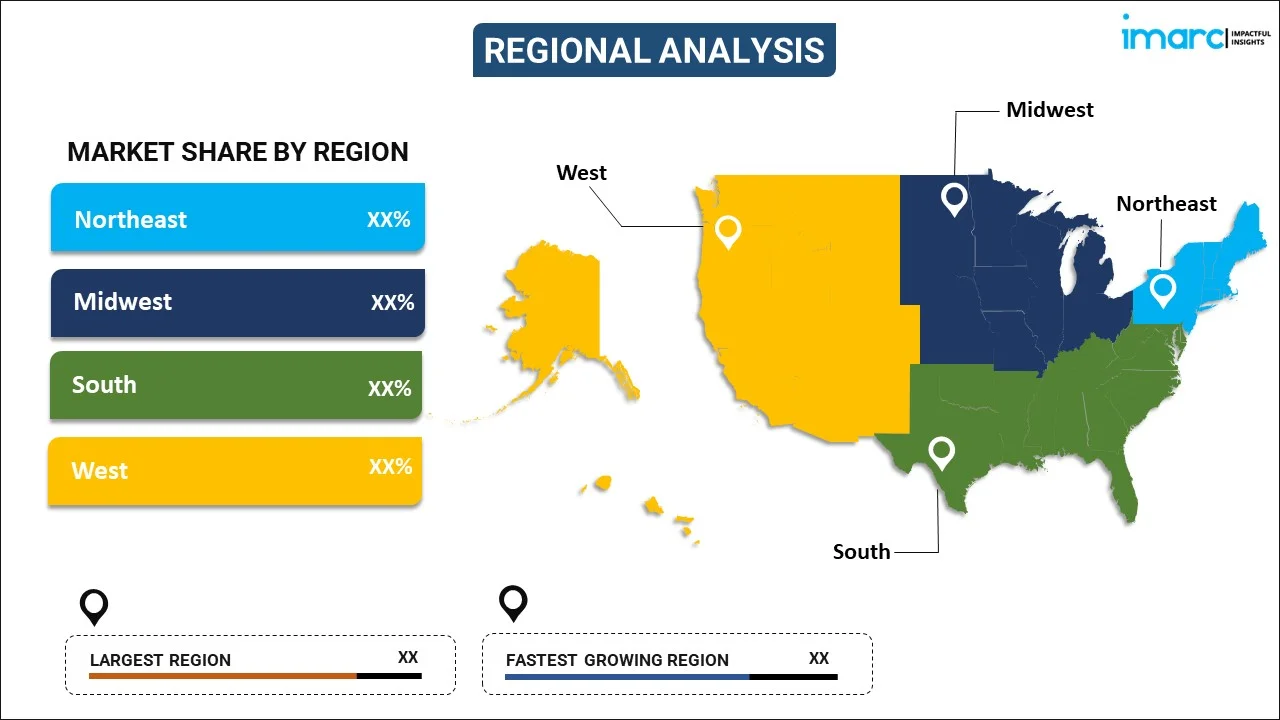
United States Employee Engagement Software Market Report by Deployment Mode (Cloud-Based, On-premises), Enterprise Size (Large Enterprises, Small and Medium Enterprises), Function (Onboarding, Training, Collaboration and Interaction, Customer Service, Rewards and Recognitions, and Others), Industry (Retail, BFSI, Government, Healthcare, IT and Telecom, Hospitality, Manufacturing, and Others), and Region 2025-2033
Market Overview:
United States employee engagement software market size reached USD 233 Million in 2024. Looking forward, IMARC Group expects the market to reach USD 952 Million by 2033, exhibiting a growth rate (CAGR) of 16.9% during 2025-2033. The widespread adoption of hybrid and remote work models, increasing reliance on data-driven decision-making, and the rising utilization of integrated software solutions in modern HR practices represent some of the key factors driving the market.
|
Report Attribute
|
Key Statistics
|
|---|---|
|
Base Year
|
2024
|
|
Forecast Years
|
2025-2033
|
|
Historical Years
|
2019-2024
|
|
Market Size in 2024
|
USD 233 Million |
|
Market Forecast in 2033
|
USD 952 Million |
| Market Growth Rate 2025-2033 | 16.9% |
Employee engagement software refers to a specialized technology solution designed to facilitate and measure employee engagement within an organization. It includes features for gathering employee feedback through surveys, polls, and direct communication channels. It offers data analysis capabilities to assess the level of engagement and identify trends and areas for improvement. It also provides communication and collaboration features to connect employees, share information, and promote a sense of community. It facilitates internal communication, team collaboration, and knowledge sharing. It can be tailored to the specific needs of an organization, allowing for the creation of surveys, assessments, and engagement strategies that align with company culture. It can help in setting goals, tracking progress, and conducting performance evaluations. It is commonly used to conduct employee surveys, which provide insights into satisfaction levels and areas for improvement. It can support training programs and career development initiatives, ensuring employees have access to the necessary resources for growth. Besides this, as it fosters a more engaged and motivated worker base, the demand for employee engagement software is increasing in the United States.
United States Employee Engagement Software Market Trends:
The rising adoption of hybrid and remote work models in the United States represents one of the primary factors driving the demand for employee engagement software to maintain effective communication and connection among dispersed teams. The rising adoption of remote working module is making it challenging for organizations to maintain a sense of unity and engagement among employees. Employee engagement software provides a platform for virtual team-building activities, recognition, and communication, helping bridge the gap created by physical distance. Along with this, several businesses are increasingly relying on data-driven decision-making, which is catalyzing the demand for employee engagement software. Employee engagement software aids in promoting inclusivity by providing a platform for open dialogue, collecting feedback on DEI efforts, and measuring progress. Furthermore, the increasing reliance of modern human resource (HR) practices on integrated software solutions is favoring the market growth. Employee engagement software can seamlessly integrate with other HR systems, creating a comprehensive platform for managing all aspects of employee engagement, ranging from recruitment to retirement. Moreover, leading vendors in the country are continuously investing in research and development (R&D) activities to innovate employee engagement software with more advanced features. This innovation results in more user-friendly interfaces, advanced analytics, and enhanced features, providing organizations with increasingly effective tools for engagement.
United States Employee Engagement Software Market Segmentation:
IMARC Group provides an analysis of the key trends in each segment of the market, along with forecasts at the country level for 2025-2033. Our report has categorized the market based on deployment mode, enterprise size, function, and industry.
Deployment Mode Insights:

- Cloud-Based
- On-premises
The report has provided a detailed breakup and analysis of the market based on the deployment mode. This includes cloud-based and on-premises.
Enterprise Size Insights:
- Large Enterprises
- Small and Medium Enterprises
A detailed breakup and analysis of the market based on enterprise size have also been provided in the report. This includes large enterprises and small and medium enterprises.
Function Insights:
- Onboarding
- Training
- Collaboration and Interaction
- Customer Service
- Rewards and Recognitions
- Others
The report has provided a detailed breakup and analysis of the market based on the function. This includes onboarding, training, collaboration and interaction, customer service, rewards and recognitions, and others.
Industry Insights:
- Retail
- BFSI
- Government
- Healthcare
- IT and Telecom
- Hospitality
- Manufacturing
- Others
A detailed breakup and analysis of the market based on industry have also been provided in the report. This includes retail, BFSI, government, healthcare, IT and telecom, hospitality, manufacturing, and others.
Regional Insights:

- Northeast
- Midwest
- South
- West
The report has also provided a comprehensive analysis of all the major regional markets, which include the Northeast, Midwest, South, and West.
Competitive Landscape:
The market research report has also provided a comprehensive analysis of the competitive landscape in the market. Competitive analysis such as market structure, key player positioning, top winning strategies, competitive dashboard, and company evaluation quadrant has been covered in the report. Also, detailed profiles of all major companies have been provided.
United States Employee Engagement Software Market Report Coverage:
| Report Features | Details |
|---|---|
| Base Year of the Analysis | 2024 |
| Historical Period | 2019-2024 |
| Forecast Period | 2025-2033 |
| Units | Million USD |
| Scope of the Report | Exploration of Historical and Forecast Trends, Industry Catalysts and Challenges, Segment-Wise Historical and Predictive Market Assessment:
|
| Deployment Modes Covered | Cloud-Based, On-premises |
| Enterprise Sizes Covered | Large Enterprises, Small and Medium Enterprises |
| Functions Covered | Onboarding, Training, Collaboration and Interaction, Customer Service, Rewards and Recognitions, Others |
| Industries Covered | Retail, BFSI, Government, Healthcare, IT and Telecom, Hospitality, Manufacturing, Others |
| Regions Covered | Northeast, Midwest, South, West |
| Customization Scope | 10% Free Customization |
| Post-Sale Analyst Support | 10-12 Weeks |
| Delivery Format | PDF and Excel through Email (We can also provide the editable version of the report in PPT/Word format on special request) |
Key Questions Answered in This Report:
- How has the United States employee engagement software market performed so far and how will it perform in the coming years?
- What has been the impact of COVID-19 on the United States employee engagement software market?
- What is the breakup of the United States employee engagement software market on the basis of deployment mode?
- What is the breakup of the United States employee engagement software market on the basis of enterprise size?
- What is the breakup of the United States employee engagement software market on the basis of function?
- What is the breakup of the United States employee engagement software market on the basis of industry?
- What are the various stages in the value chain of the United States employee engagement software market?
- What are the key driving factors and challenges in the United States employee engagement software?
- What is the structure of the United States employee engagement software market and who are the key players?
- What is the degree of competition in the United States employee engagement software market?
Key Benefits for Stakeholders:
- IMARC’s industry report offers a comprehensive quantitative analysis of various market segments, historical and current market trends, market forecasts, and dynamics of the United States employee engagement software market from 2019-2033.
- The research report provides the latest information on the market drivers, challenges, and opportunities in the United States employee engagement software market.
- Porter's five forces analysis assist stakeholders in assessing the impact of new entrants, competitive rivalry, supplier power, buyer power, and the threat of substitution. It helps stakeholders to analyze the level of competition within the United States employee engagement software industry and its attractiveness.
- A competitive landscape allows stakeholders to understand their competitive environment and provides an insight into the current positions of key players in the market.
Need more help?
- Speak to our experienced analysts for insights on the current market scenarios.
- Include additional segments and countries to customize the report as per your requirement.
- Gain an unparalleled competitive advantage in your domain by understanding how to utilize the report and positively impacting your operations and revenue.
- For further assistance, please connect with our analysts.
 Inquire Before Buying
Inquire Before Buying
 Speak to an Analyst
Speak to an Analyst
 Request Brochure
Request Brochure
 Request Customization
Request Customization




.webp)




.webp)












